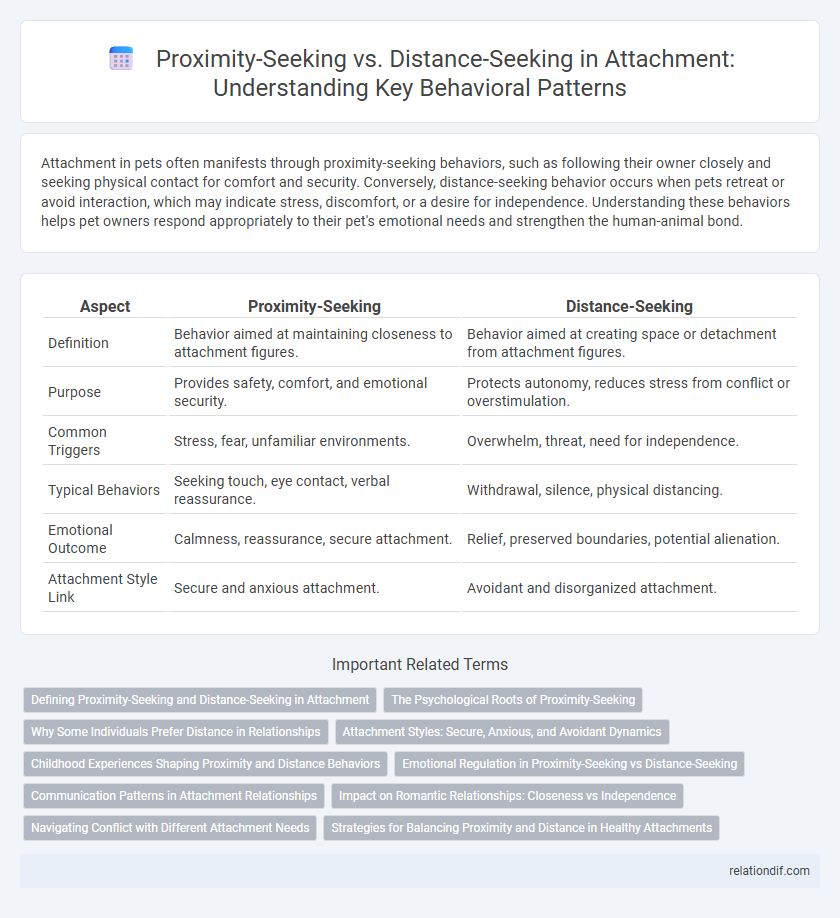Attachment in pets often manifests through proximity-seeking behaviors, such as following their owner closely and seeking physical contact for comfort and security. Conversely, distance-seeking behavior occurs when pets retreat or avoid interaction, which may indicate stress, discomfort, or a desire for independence. Understanding these behaviors helps pet owners respond appropriately to their pet's emotional needs and strengthen the human-animal bond.
Table of Comparison
| Aspect | Proximity-Seeking | Distance-Seeking |
|---|---|---|
| Definition | Behavior aimed at maintaining closeness to attachment figures. | Behavior aimed at creating space or detachment from attachment figures. |
| Purpose | Provides safety, comfort, and emotional security. | Protects autonomy, reduces stress from conflict or overstimulation. |
| Common Triggers | Stress, fear, unfamiliar environments. | Overwhelm, threat, need for independence. |
| Typical Behaviors | Seeking touch, eye contact, verbal reassurance. | Withdrawal, silence, physical distancing. |
| Emotional Outcome | Calmness, reassurance, secure attachment. | Relief, preserved boundaries, potential alienation. |
| Attachment Style Link | Secure and anxious attachment. | Avoidant and disorganized attachment. |
Defining Proximity-Seeking and Distance-Seeking in Attachment
Proximity-seeking in attachment refers to behaviors aimed at maintaining closeness and physical or emotional contact with an attachment figure, ensuring safety and comfort. Distance-seeking involves intentional withdrawal or maintaining physical or emotional space to protect oneself from perceived threats or distress within attachment relationships. These opposing strategies regulate emotional needs by balancing the desire for intimacy with the need for autonomy in attachment bonds.
The Psychological Roots of Proximity-Seeking
The psychological roots of proximity-seeking behavior are deeply anchored in the human need for safety and emotional security, often originating from early attachment experiences with primary caregivers. This innate drive motivates individuals to maintain close physical or emotional closeness to attachment figures, especially during times of stress or perceived threat, to regulate emotions and reduce anxiety. Neuroscientific studies reveal that proximity-seeking activates brain regions associated with reward and stress relief, highlighting its evolutionary role in survival and social bonding.
Why Some Individuals Prefer Distance in Relationships
Some individuals prefer distance in relationships due to attachment styles rooted in early experiences, such as avoidant attachment, which fosters discomfort with closeness and dependence. These individuals often seek emotional autonomy and maintain boundaries to protect themselves from perceived vulnerability or potential rejection. Psychological factors like fear of intimacy and past trauma contribute to a preference for emotional and physical space within close relationships.
Attachment Styles: Secure, Anxious, and Avoidant Dynamics
Attachment styles profoundly influence proximity-seeking and distance-seeking behaviors in relationships, with secure individuals comfortably balancing closeness and independence. Anxious attachment often drives intense proximity-seeking due to fear of abandonment, while avoidant attachment manifests as distance-seeking to maintain emotional self-protection. These dynamics shape interpersonal interactions, emotional regulation, and relationship satisfaction across various social contexts.
Childhood Experiences Shaping Proximity and Distance Behaviors
Childhood experiences with caregivers significantly shape proximity-seeking and distance-seeking behaviors, forming the foundation of attachment styles. Consistent responsiveness fosters secure attachment, promoting healthy proximity-seeking behaviors as a source of comfort and safety. In contrast, neglect or inconsistent caregiving often leads to distance-seeking tendencies, where children learn to suppress emotional needs to maintain autonomy or self-protection.
Emotional Regulation in Proximity-Seeking vs Distance-Seeking
Emotional regulation in proximity-seeking involves actively seeking closeness to attachment figures to alleviate stress and enhance feelings of safety, which boosts emotional stability through physical or emotional comfort. In contrast, distance-seeking strategies regulate emotions by creating space from attachment figures, helping individuals manage anxiety and regain autonomy during distress without direct reassurance. These distinct approaches highlight how proximity and distance serve as adaptive mechanisms for modulating emotional responses in attachment relationships.
Communication Patterns in Attachment Relationships
Proximity-seeking behavior in attachment relationships often involves frequent, open communication characterized by emotional sharing and reassurance requests, which foster closeness and trust. Distance-seeking patterns tend to feature minimal or guarded communication, signaling a need for autonomy while often maintaining emotional boundaries. Understanding these communication styles is crucial for identifying attachment needs and promoting healthy relational dynamics.
Impact on Romantic Relationships: Closeness vs Independence
Proximity-seeking behavior fosters emotional closeness and strengthens intimacy in romantic relationships by promoting frequent interactions and mutual support. Distance-seeking behavior, while sometimes causing temporary tension, supports individual independence and personal growth, contributing to a healthy balance between closeness and autonomy. Successful relationships often navigate the dynamic interplay between seeking connection and maintaining personal space to enhance overall satisfaction.
Navigating Conflict with Different Attachment Needs
Proximity-seeking behavior in attachment reflects a desire for closeness and reassurance during conflict, while distance-seeking aims to create space for emotional regulation and autonomy. Navigating conflicts requires recognizing these divergent needs to foster mutual understanding and prevent escalation. Tailoring communication to respect both proximity and distance preferences enhances relationship resilience and emotional security.
Strategies for Balancing Proximity and Distance in Healthy Attachments
Effective strategies for balancing proximity and distance in healthy attachments include open communication of needs and boundaries, which fosters mutual understanding and respect. Implementing consistent patterns of availability and autonomy helps individuals feel secure while maintaining personal space. Establishing trust through reliable responsiveness supports emotional closeness without overwhelming dependency.
Proximity-seeking vs distance-seeking Infographic

 relationdif.com
relationdif.com